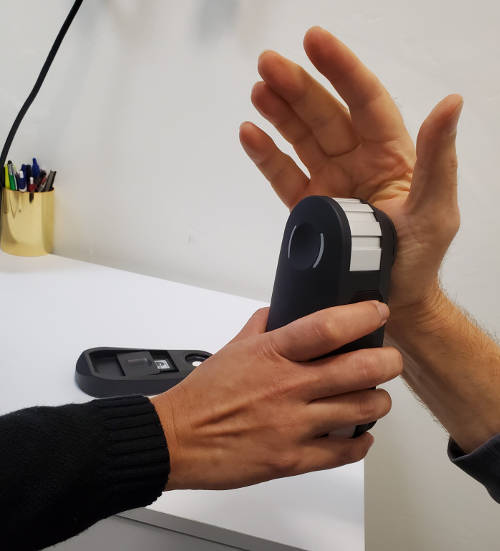Environmental Toxins and Parkinson's Disease:
There are reported links between specific industrial neurotoxins, toxic metals and agricultural pesticides/herbicides and neurodegenerative diseases such as Parkinson's. One can have a urine or tissue test to detect for elevated levels of these neurotoxins. Those diagnosed with Parkinson's disease (PD) are encouraged to find the source of their condition, remove it and to detoxify. The best approach is of course to never have been exposed to neurotoxic chemicals as detoxification, if possible, may not reverse the damage done. While the association between many toxic chemicals and cancer are well known, the association to Parkinson's is less evident. While the association with cancer should be enough to want to avoid chemical toxins, we will only be covering those affiliated with Parkinson's disease.
There are also some stong correlations with certain industrial trades and Parkinson's disease. Aerospace workers working with the solvent trichloroethylene were found to be six times more likely to develop Parkinson's. (ref: Solvent exposure) Farm workers who work with herbicides and pesticides are at an elevated risk of getting Parkinson's disease. One study showed that those lived in a home five hundred meters from a farm field which employed the use of the weed killer Paraquat or maneb, had an increased risk of Parkinson's disease of 75% compared to the general population! (ref: Parkinson's Disease and Residential Exposure) Farm workers who handled the herbicide were at an increased risk of 250%! (ref: Rotenone, Paraquat, and Parkinson’s Disease)
The list of toxic chemical associations are growing and so is their use.
Also see mold toxins and Parkinson's disease and mercury and Parkinson's disease.
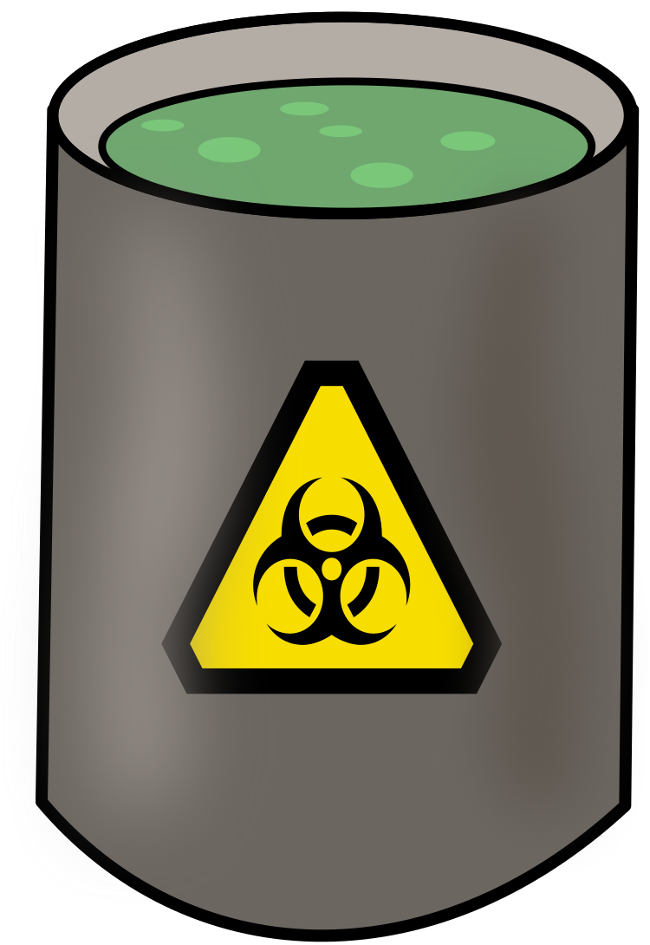
Toxins linked to Parkinson's Disease:
| Toxin | Description | Detox |
|---|---|---|
| Carbon Monoxide | Carbon Monoxide poisoning or even elevated levels of exposure are linked to the development of Parkinson's.
References: | Breath clean air, improve ventilation |
| Radon | Radon is a radioactive gas and human carcinogen emitted naturaly from the ground in some geographic regions.
References:
| Breath clean air, improve ventilation |
| MPTP | This chemical is derived from the production of synthetic heroine and has a direct and immediate effect in the cause of symptoms of parkinsonism.
Neurologists discovered this link when a group of intravenous drug users in California in the 1980s injected a synthetic heroin that had been contaminated with MPTP.
MPTP is associated with mitochondrial dysfunction.
In research, MPTP is often used to cause Parkinson's in lab rats.
While it is a dangerous chemical, it is not found by accidental exposure.
Reference: MPTP-Induced Parkinsonian Syndrome | |
| 1-methyl-4-phenylpyridinium (MPP+) | This chemical is a neurotoxin associated with mitochondrial dysfunction. It is a compound closely related to MPTP.
Chemically similar to the pesticides Rotenone and Paraquat.
References: | |
| Dithiocarbamates (maneb, zineb, ziram) |
this class of chemical is used as a fungiside and causes dopaminergic neurodegeneration, disrupts mitochondrial function, increases oxidative stress, and inhibits proteasomal function.
Reference:
| |
| Epoxomicin | This chemical is a naturally occurring selective proteasome inhibitor which inhibits a neuron cell's ability to clean-up alpha-synuclein.
Causes proteasomal and lysosomal dysfunction inducing Parkinson's symptoms.
References: | |
| Lipopolysaccharide (LPS) | This chemical is a bacterial endotoxin (generated internal to the bacteria as opposed to exotoxins which are released by the bacteria) generated by the Gam-negative bacteria.
It is used in research as a glial activator for the induction of inflammatory dopaminergic neurodegeneration.
Causes nitrative stress and glial cell activation.
Reference: The Lipopolysaccharide Parkinson's disease animal model: mechanistic studies and drug discovery (2008) | |
| polychlorinated biphenyls (PCBs) | This fire retardant is banned but has been found in high concentrations in the brains of people who had Parkinson’s.
Reference: | |
| Tetrachloroethylene perchloroethylene (PERC) |
used as a dry cleaning solvent and can persist in groundwater for decades. Similar to Trichloroethylene (TCE).
Increases markers of oxidative stress, activate microglia, and disrupt mitochondrial function.
Absorbed via respiration or ingestion and freely crosss the blood-brain-barrier (BBB).
Metabolized through either conjugation with glutathione (GSH) or oxidation by P450 system pathway.
Reference:
| Glutathion, activated charcoal |
| Tiglylglycine (TG) | This compound is a marker for mitochondrial disorders resulting from mutations of mitochondrial DNA, which can manifest from exposure to toxic chemicals, infections, inflammation, and nutritional deficiencies. TG indicates mitochondrial dysfunction by monitoring a metabolite that is elevated in mitochondrial deficiency of cofactors such as NAD+, flavin-containing coenzymes, and Coenzyme Q10. Disorders associated with mitochondrial dysfunction include autism, Parkinson’s disease, and cancer (as stated by Great Plains Labs (GPL) but could not find any other literature expressing this connection). In the medical literature, a normal value is less than 3.8 mmol/mol creatinine in children. Elevated TG should be considered a better marker of mitochondrial dysfunction than lactate or pyruvate levels. | Coenzyme Q-10 (300-600 mg), NAD 25 mg, L-carnitine and acetyl-L-carnitine (1000-2000 mg), riboflavin (40-80 mg), nicotinamide (40-80 mg), biotin (4-8 mg), and vitamin E (200-400 IU’s) per day may improve mitochondrial dysfunction . Hyperbaric oxygen therapy (HBOT) may also be beneficial. |
| Trichloroethylene (TCE) | This solvent can be found in degreasing agents, dry cleaning fluid, adhesives and paint thinners.
It is also used to extract vegetable oils, in coffee decaffeination, and the preparation of flavouring extracts from hops and spices.
Those exposed during employment are six times more likely to develop Parkinson's disease.
Trichloroethylene is a significant component of 50% of the superfund sites in the US including silicon valley where it was used in the cleaning and processing of silicon chips.
Trichloroethylene pollutes up to 30% of groundwater and indoor air in the US.
References: | Glutathion, activated charcoal |
| Pesticides and Herbicides | ||
| 2,4-dichlorophenoxyacetic acid (2,4-D) | This herbicide was a major component of Agent Orange used during the Vietnam war.
Commonly used in agriculture on genetically modified foods, and as a weed killer for lawns and is a known endocrine disruptor.
References:
| Sauna treatment. Detoxification protocol employing niacin, vitamin B-12, glutathione supplementation or precursors such as N-acetyl cysteine (NAC). ref GPL "Toxic Non-metal Chemical Profile" results interpretation. |
| Glyphosate | Glyphosate is the active ingredient in the weed killer "Round Up" and had been found in multiple studies to be linked as a cause of Parkinson's disease.
Washington State University study:
Webinar recording: Glyphosate, the main ingredient in herbicides and Parkinson’s Disease and Beyond - Dr Shanhong Lu MD PhD | Glutathion, activated charcoal |
| Organophosphorus Pesticides (Chlorpyrifos, Diazinon, Diazoxon, Dursban, Malathion, Methyl Parathion, Paroxon, etc)
(Test for Diethylphosphate (DEP), Dimethylphosphate (DMP)) |
Organophosphorous pesticides (also known as Organophosphates) are used in agriculture and in household pesticides and are significantly associated with Parkinson's Disease.
The frequent use of household pesticides that contain organophosphorus chemicals increased the chances of developing Parkinson's Disease by 71%.
Note that Chlorpyrifos, the organophosphate agent of dursban, is found in some popular household roach and ant sprays, including Raid and Black Flag and commonly found on golf courses and tobacco fields.
Organophosphates exert their toxic effects by inhibiting the activity of acetylcholinesterase at nerve endings, leading to the accumulation of the neurotransmitter acetylcholine, and affecting the parasympathetic, sympathetic, motor, and central nervous systems. Also see Genetic links and gene PON1-55 for susceptibility to organophosphates.
Reference: Household Organophosphorus Pesticide Use and Parkinson's Disease |
Acute poisoning: atropine and/or pralidoxime. Oximes (pralidoxime or obidoxime), and benzodiazepines (e.g., diazepam).
Enzymatic detoxification of organophosphorus pesticides and related toxicants Literature does not address treatments for chronic low exposure from traditional food on which pesticides have been applied. Avoid further intake by consuming organic produce. Also see study of the neuroprotective potential of saffron against malathion |
| Organochlorine: beta-hexachlorocyclohexane
(DDT (dichlorodiphenyltrichloroethane), aldrin, dieldrin, endrin, endosulfan, benzene hexachlorides (e.g., lindane), heptachlor, methoxychlor, and chlordane) |
This class of pesticides has been implicated as environmental risk factor for the development of Parkinson’s disease.
Although many pesticides in this class have been banned, they are extremely persistent lipophilic compounds which bioaccumulate in the food chain and still commonly found in human tissue.
Reference: β-Hexachlorocyclohexane Levels in Serum and Risk of Parkinson’s Disease
Dieldrin: this insecticide was once used on crops (until 1970) and termites (until 1987) and is selectively toxic to dopaminergic nigral neurons and associated with oxidative stress, mitochondrial dysfunction, protein aggregation, and apoptosis.
Lindane: this insecticide was once used in agriculture (until 1970 in US, 2009 world ban) and continues to be used to treat pets and human for scabies and lice, is associated with a decrease in brain dopamine and substantial PD risk.
| |
| Paraquat | This herbicide is associated with mitochondrial dysfunction and oxidative stress affecting Parkinson's.
Exposure to Paraquat increases the risk of Parkinson's by 150%.
Paraquat is widely used on corn, soybean and apple crops.
Destroys dopamine producing neurons in the substantia nigra in a similar fashion to MPTP and MPP+.
Chemically similar to Rotenone and MPP+.
References:
| |
| Permethrin (3PB) | 3-phenoxybenzoic acid (3PBA) can be detected in a urine test and is a result of exposure to Permethrin.
It is synthesized from the Chrysanthemum genus of flowers and forms a group of pesticides known as Pyrethroids which includes permethrin, cypermethrin, deltamethrin, cyhalothrins, fenpropathrin and trihalomethrin.
This incecticide has been associated with Parkinson's.
Studies on rats showed decreased levels of dopamine in the striatum, loss of dopaminergic neurons in the substantia nigra pars compacta and cognitive impairments.
References: | Sauna treatment. Detoxification protocol employing niacin, vitamin B-12, glutathione supplementation or precursors such as N-acetyl cysteine (NAC). ref GPL "Toxic Non-metal Chemical Profile" results interpretation. |
| Rotenone | This insecticide is associated with mitochondrial dysfunction and oxidative stress affecting Parkinson's.
Rotenone can cross cell membranes and is therefore likely able to affect all cells.
Rotenone is commonly used to treat parasitic mites on chickens and other fowl, and so can be found in poultry.
Also used by fisheries to eliminate invasive fish species.
Chemically similar to Paraquat and MPP+.
References: | |
| Trifluralin | Trifluralin is generally applied to the soil as a herbicide to control the growth of grass and broadleaf weeds.
References:
| |
| Toxic Metals | ||
| Aluminum | Aluminum is a bioaccumulative neurotoxin which has been implicated in neurodegenerative diseases including Parkinson's disease.
Accumulation of aluminum in the brain and nervous system promotes oxidative stress, denervation atrophy (leading to muscle loss), disrupted mineral uptake and cellular degradation.
Aluminum can be found in antiperspirants, cosmetic astringents, stomach antacids (eg. Maalox, Mylanta), baking powder, cookware (cans, pans and foil), food packaging and drinking water.
References:
References:
| desferrioxamine (DFO), deferiprone, deferoxamine mesylate, Silicic acid (SiOH4: oxygenated silica), bentonite clay, flouride (also a neurotoxin), citric acid, magnesium, EDTA. Chris Exley, PhD, of Keele University recommends mineral water high in silica (Spritzer, Volvic). Ref Non-invasive therapy to reduce the body burden of aluminium in Alzheimer's disease (Exley et al, 2006)
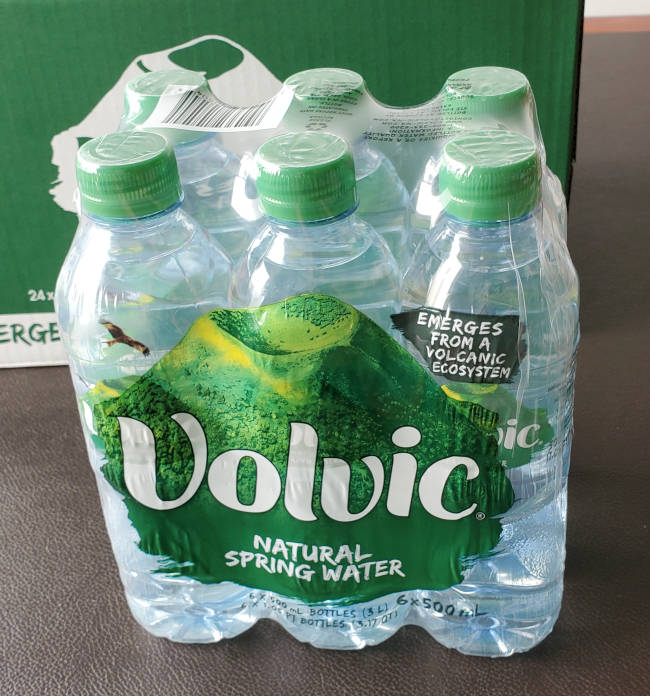
Volvic water contains 32 mg/L silica/500mL bottle, 12 L water/case 
Fiji water contains 93 mg/L silica (1 bottle) Silica (eg Eidon silica mineral supplement) also available as a concentrate which can be added to water (2 ml added to 8 oz water). |
| Arsenic | Arsenic (As) is a metalloid found naturally in both organic and inorganic form in the earth and ground water as well as in industrial waste, pesticides, fertilizers and wood preservatives.
References:
| chelation with DMSA, BAL, DMPS or penicillamine |
| Cadmium | Cadmium is a neurotoxin which has been implicated in neurodegenerative diseases including Parkinson's disease.
References:
| Minerals: Zinc, selenium, manganese. Chelation: DMPS, EDTA, DMSA. SH: GSH, Methionine
Sauna therapy |
| Iron | Wang and colleagues (2017) stated that iron accumulation in substantia nigra pars compacta (SNpc) has been proved to be a prominent pathophysiological feature of Parkinson's diseases, which can induce the death of dopaminergic neurons, up-regulation and source of reactive oxygen species (ROS), and further loss of motor control.
References:
| Iron chelation therapy with PMPC to delay the saturation of iron chelators and prolong the in-vivo lifetime.
The iron chelator deferiprone has shown success in improving motor function. |
| Lead | Lead has been associated with a decrease in dopamine synthesis, a decrease in dopamine reuptake in midbrain neurons, a decrease in neuron dopamine receptor sensitivity and an elevated risk of Parkinson's.
References:
| Activated charcoal, ethylenediaminetetraacetic acid (EDTA), DMSA, Cytodetox, NAC, R-Alpha Lipoic Acid, Niacin |
| Manganese | High-dose manganese exposure is known to cause a form of parkinsonism called manganism.
This condition can be contracted in occupations such as welding.
Note that many daily multi-vitamins contain low doses of Manganese and it is an essential nutrient found in whole grains, legumes, beans, nuts, ...
At toxic levels, it accumulates in mitochondria, where it disrupts oxidative respiration, catalyzes dopamine oxidation, and activates microglia (brain immune system).
References:
| Diatomaceous Earth, Organic Silica |
| Mercury | Mercury has been associated with an elevated risk of Parkinson's symptoms and overall oxidative stress and cell death.
References:
| DMSA, NBMI (Emeramide)
Also see Mercury chelation |
| Environmental Contaminant | Description | Detox |
| Microplastics/Polystyrene | Nanoparticles (less than 1 μm) of polystyrene can promote the clumping of the alpha-synuclein protein involved in Parkinson’s.
Research has shown that unlike other kinds of plastic, polystyrene nanoparticles can enter the brain.
References: | Avoid polystyrene cups and packing material. |
| Bisphenol A (BPA) | BPA is a ubiquitous estrogen-mimetic molecute with well established effects on the dopaminergic system.
References:
| Avoid dental sealants, canned food, microwaving food in plastic containers, ... |
There are many currently banned substances such as DDT, Agent Orange, heptachlor and dieldrin which were once in wide use and have contributed to Parkinson's in older patients.
Also see: NIH-funded twin study finds occupational chemical exposure may be linked to Parkinson's risk
Tests:
Testing systems.
- MELISA: blood test to determine metal sensitivity.
MELISA test measures whether the immune system reacts to specific metals: it does not measure the levels of metals in the body.
MELISA tests are performed by MELISA licensed laboratories.
(MEmory Lymphocyte Immuno-Stimulation Assay)
Testing Laboratories:
These services often require a doctor's order for a test.
- Great Plains Laboratory (GPL) Inc: Lenexa KS
urine test. Results include suggested detox protocols. - Doctor's Data Inc: global
hair, blood, stool, urine - Labcorp:
full spectrum of tests - Trace Elements Inc: Texas
hair tests, drinking water - VibrantWellness: California
urine tests for heavy metals, mycotoxins, food sensitivities, etc - Quicksilver Metals Testing:
CLIA-certified laboratory specializes in advanced mercury Tri-Test (hair, blood, and urine) - Rocky Mountain Analytical: Canada and a limited number of provinces
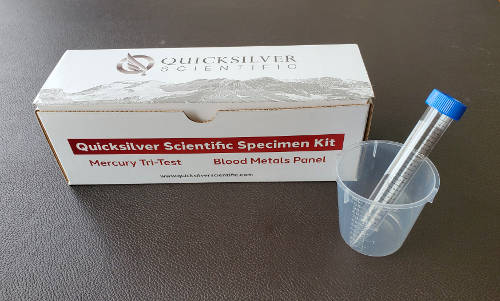
Quicksilver mercury Tri-test: includes two blood vials and urine vial, instructions and mail pouches
Testing Requisitions:
These services provide a doctor's order for a test.
- Private MD Labs:
Supports Labcorp or Quest lab tests - Direct Labs: global. Provides doctors orders for tests
- Accesa Labs:
- Your Lab Work: US (New Jersey, New York, Maryland, and Rhode Island excluded)
- My Labs for Life:
Supports Quest lab tests - Dr. Shanhong Lu MD PhD: Shasta CA
Free. Donations optional.
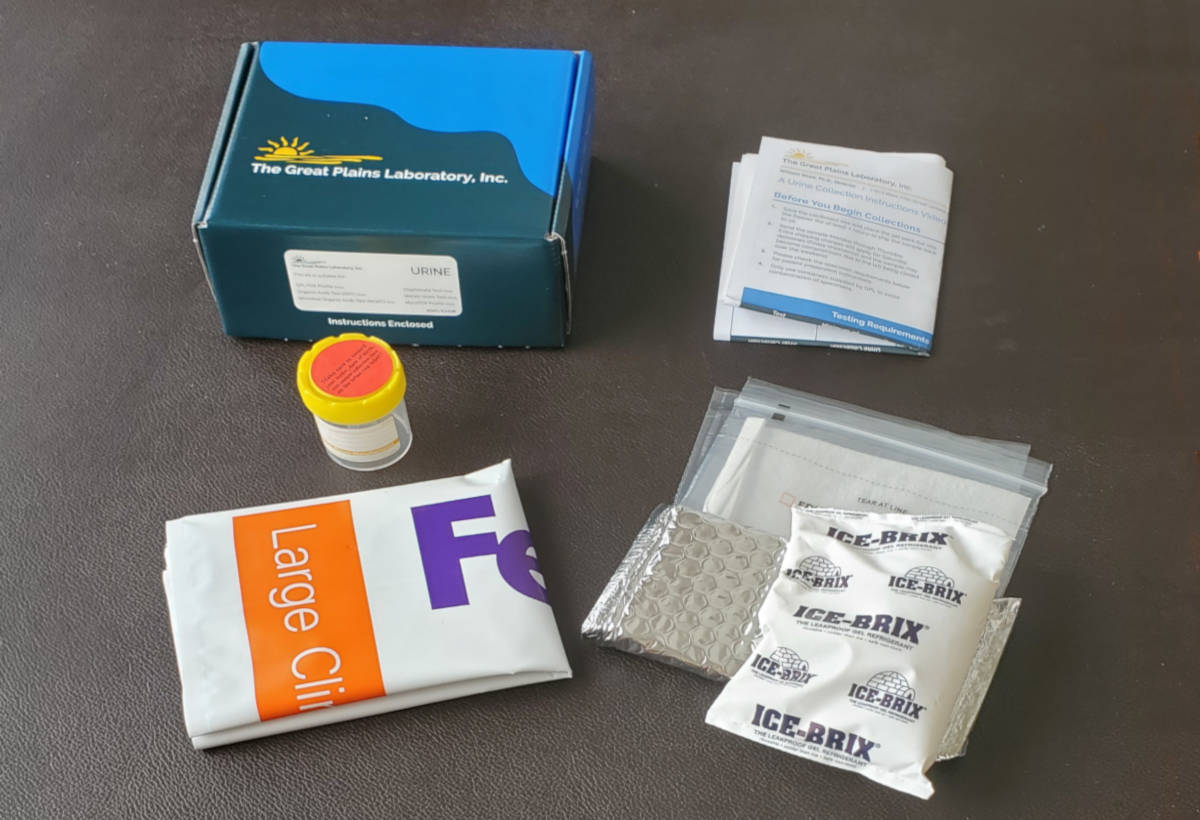
Great Plains Laboratory urine sample kit: pee in the cup, freeze it, pack it and send it

Heavy Metals Test - OligoScan:
The OligoScan is a toxic metals scan which unlike the blood test can actually measure the body burden in tissue which makes the measurement much more relevant.
This is also the reason that an OligoScan is used to measure chronic intoxication (accumulated over time) rather than acute intoxication (momentary).
It uses light spectroscopy (spectrophotometry) to measure the levels directly in the tissue being scanned (typically the hand).
It is based on the scientific principle that every chemical element absorbs, emits or reflects light (electromagnetic radiation) of a given wavelength.
The more the tissue is concentrated with a given element, the more it absorbs the light of a corresponding specific wavelength (Beer-Lambert's law).
The values measured are calibrated to the gender, size, weight and blood type of the patient.
Also see OligoScan
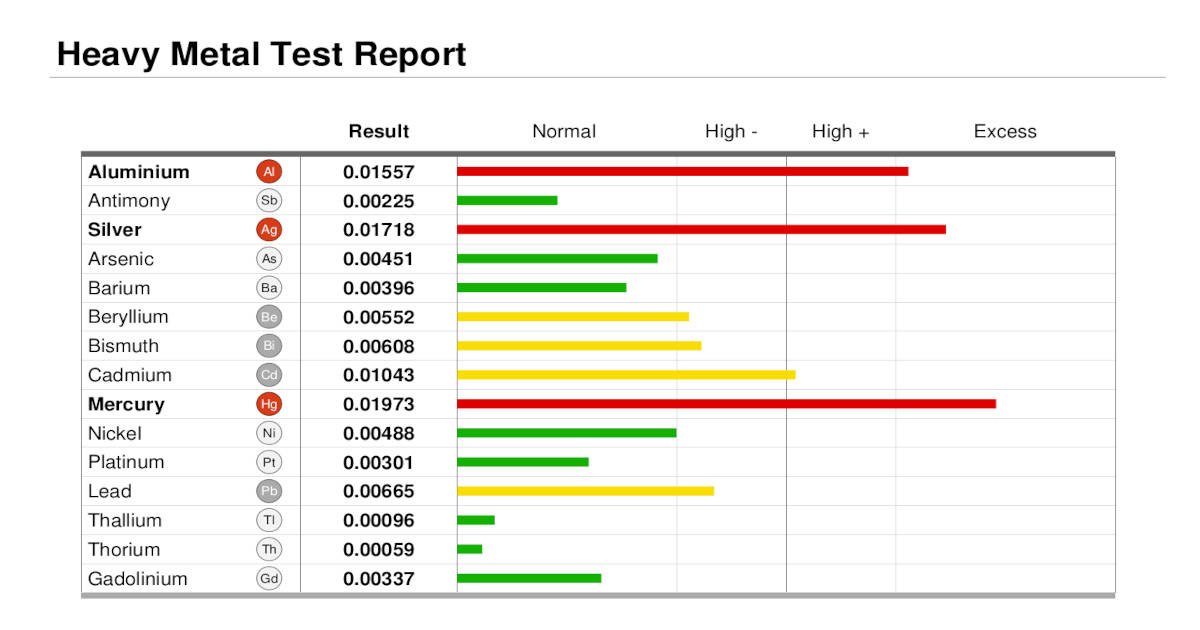
Example OligoScan Heavy Metal Test Report. Note that the result values are not of standard units like micro-grams per liter so comparisons with blood tests are futile. Additional OligoScan tests can be merged into comparison reports to track progress.
Tap Water:
The Environmental Working Group (EWG) runs an online database of toxins found in the drinking water based on US zip codes. The database is formed from 32 million state water records from nearly 50,000 utilities. Enter your US zip code on the EWG website.
Also see:Flouride has also been found to be an endocrine disruptor (it alters normal endocrine function and response) and a neurotoxin, although there has been no direct link to Parkinson's disease.
Also see:
- YouTube video: Is Drinking Fluoride Safe
- Developmental Fluoride Neurotoxicity: A Systematic Review and Meta-Analysis (2012)
- Fluoride: Potential Developmental Neurotoxicity (2016) National Toxicology Program (NTP), U.S. Department of Health and Human Services
Tap Water Test Kits:
- Tap Score: top rated by NY Times
- National Testing Laboratories: CityCheck
- SafeHome
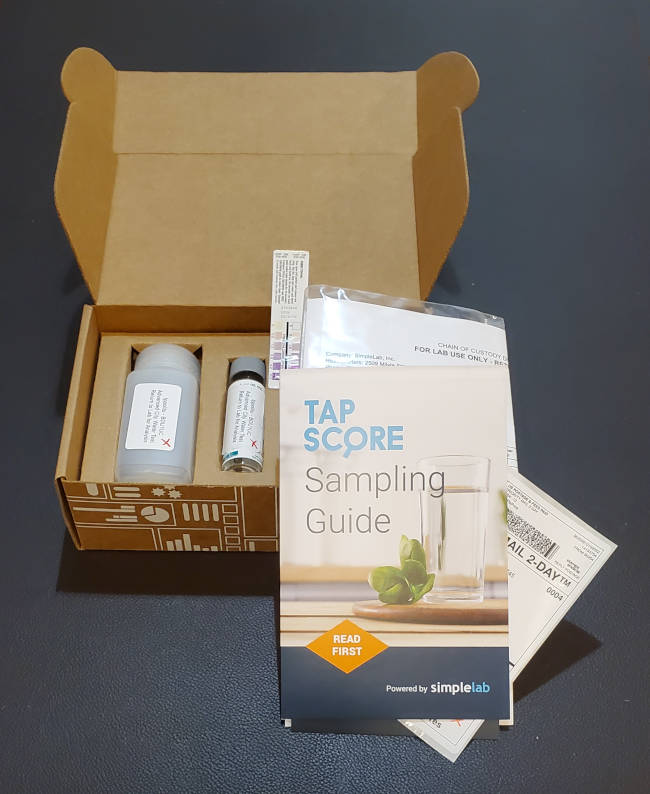
Tap water test kit: Tap Score (Simple Lab)
Detoxification:
The detox regiment for each toxin is different. Heavy metals are typically removed using "Chelation therapy", a procedure that involves the administration of chelating agents to remove heavy metals from the body. Chelation therapies may have side effects which are worse than the toxin. Detox and chelation therapies should only be administered by a medical professional.
Saunas are often used as a detox therapy as sweat can be an exit corridor for toxins such as petrochemicals as well as metals. Since sweating in a sauna pulls a lot of electrolytes and minerals from your body, it's important to drink sufficient quantities of water as well as replenish salts and electrolytes.
Exercise is another promoter of sweat to flush toxins from the body. It also tends to burn body fat which will release additional toxins stored there so it is often paired up with chelating nutrients and supplements.
Activated Charcoal is a form of carbon which forms a bond with toxins. After bonding with toxins like mold toxins, BPA or pesticides, ingested charcoal can continue to pass through with your bowel movement to excrete both the activated charcoal and the toxins bonded to it. Also see binders
Diet which targets fat loss such as one that achieves ketosis will have a similar effect to exercise and can be coupled with activated charcoal to purge the toxins released from your fat.
Supplements such as Calcium-D Glucarate (liver detox), precursors to Glutathion (NAC, Glutamate, Glycine) and others have been known to help detoxify the body. Guidance from a health professional is crucial to helping detoxify your body and not causing further damage.
One might think that the detoxification process should be guided by a toxicologist medical doctor. Unfortunately that is not how the medical system is structured. Toxicologists are rare and associated with larger hospitals and medical institutions and fall under the Emergency Room (ER) jurisdiction. Thus one can not schedule a visit with a toxicologist as they consult with ER doctors primarily about overdoses and poisonings. Even in ER they rarely see patients and primarily act as consultants. This is very unfortunate as it forces many to work with holistic practitioners or on their own, guided by what they read on the internet at a time when they need a doctor's guidance.
Also see:- Mercury chelation: mercury detoxification
- Glucuronidation: mechanism for the formation of water-soluble substrates from xenobiotics (artificial toxins), leading to their elimination from the body in bile or urine
Books:
Goldfrank's Toxocologic Emergencies: This is the toxicology textbook you will find in most hospital Emergency Rooms and poison centers.
Authors: Nelson, Hoffman, et al. 2019
ISBN: 978-1259859618

Chelation Therapy in the Treatment of Metal Intoxication: Covers therapies, chelators, chemistry kinetics and diseases of metals intoxication.
Authors: Jan Aaseth, Guido Crisponi, Ole Anderson
Academic Press 2016
ISBN: 978-0-12-803072-1
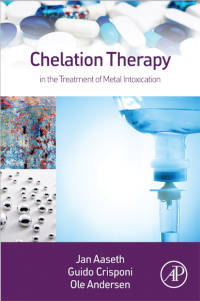
Additional Web Resources:
- NAWQA: Estimated Annual Agricultural Pesticide Use - maps and tables
NAWQA: National Water-Quality Assessment Project - EPA Superfund website - maps, reports and data
EPA: Environmental Protection Agency - EWG: Tap water pollutants by US zip code.
EWG: Environmental Working Group
Pros:
- No negative side effects to getting tested. Removing one's self from a toxic chemical environment or having one's environment purged of chemical toxins will protect one's self from a multitude of ailments.
Cons:
- Rectifying a toxic chemical environment may not halt the progression of Parkinson's or cure Parkinson's but it may remove an accelerant to one's neurological decline and avoid other ailments. Detox and chelation therapies on the other hand may have side effects which are worse than the toxin. Detox and chelation therapies should only be administered by a medical doctor.
